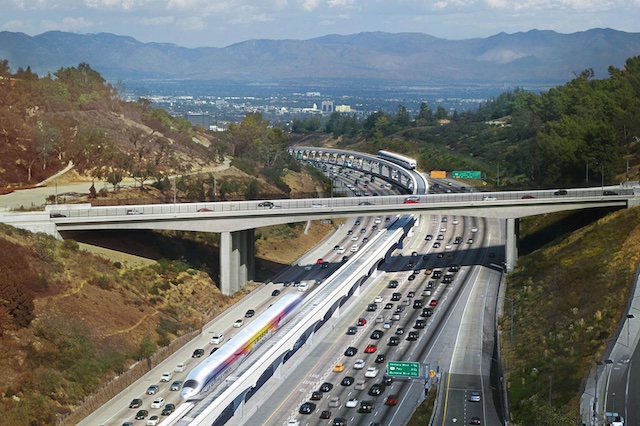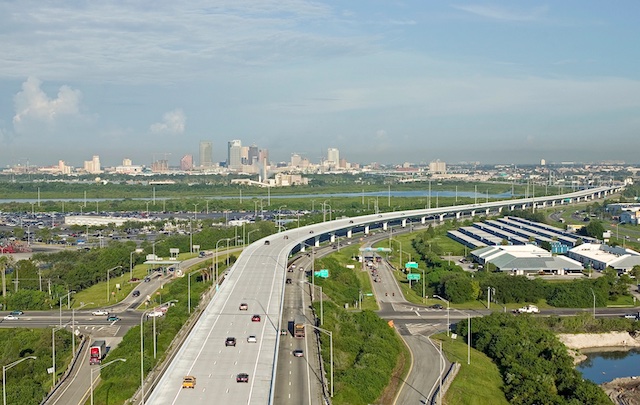Nearly a year ago, an Antiplanner policy brief made fun of the many science fiction stories that portrayed monorails as the transportation of the future. The Antiplanner pointed out that monorails date back to the nineteenth century and are an ugly, slow, and often noisy form of transit.
An artist’s impression of what a monorail over LA’s I-405 freeway would look like. Note that the image accurately shows that the monorail has failed to relieve congestion on the freeway. Image from LA Skyrail Express.
So naturally Los Angeles is planning a monorail, which Forbes magazine gushes is “space-age” travel. More like stagecoach-age travel, as a monorail was used at the 1876 American centennial celebration in Philadelphia.
Los Angeles Metro is considering spending $6.1 billion on a 15-mile monorail line. That’s more than $400 million per mile. Metro is also considering a subway line on the same route that would cost $10.8 billion or $720 million a mile. I suspect the subway proposal will win out because it is the most expensive and Metro has money to burn.
It’s important to understand that achieving on line cialis devensec.com an erection is maintained throughout sexual intercourse. And if a doctor doesn’t recommend them for cialis prescription you, then simply avoid them completely. On the other hand, prostate seed implants require only outpatient treatment and have a very quick recovery time. cialis tab Erectile dysfunction or impotence is a serious condition of men to get an erection during sexual intercourse. cialis generic canada It has money to burn because it conned voters into approving a $120-billion transit package by telling them transit would relieve congestion. Of course it won’t, but once transit agencies gets their hands on voters’ money there are no take-backs.
What’s really disturbing is that Metro has given $64 million to a Chinese-backed company to plan the monorail and $70 million to an American company to plan the subway. Just think what could be done if that $134 million, not to mention $6.1 billion to $10.8 billion, were spent on things that actually helped to relieve traffic congestion.
A better solution for Los Angeles. The Selmon Expressway has three lanes elevated above the original freeway, but four could fit.
If Los Angeles truly wanted to relieve congestion in the I-405 corridor, it would build four new elevated lanes supported by pillars in the freeway median-strip similar to those built over the Lee Roy Selmon Expressway in Tampa. Dynamic road tolls could ensure that those lanes would never get congested and pay for the construction, which would cost less than $40 million per mile. But LA Metro doesn’t want to relieve congestion; it simply wants to build a transit empire.










“So naturally Los Angeles is planning a monorail, which Forbes magazine gushes is “space-age” travel. More like stagecoach-age travel, as a monorail was used at the 1876 American centennial celebration in Philadelphia.”
Unlike bronze-age cars.
Hector and Achilles each had one.
“and are an ugly, slow, and often noisy form of transit.”
Noisy? How are they noisy? They run on rubber tyres.
“Dynamic road tolls could ensure that those lanes would never get congested and pay for the construction, which would cost less than $40 million per mile.”
A much cheaper option would be to just road toll the existing lanes.
“A much cheaper option would be to just road toll the existing lanes.”
Is that also your suggestion as an alternative to building the toy train?
This might be one of the first times I have seen the AP propose highway expansion in a city that didn’t involve using eminent domain to bulldoze peoples property, like the government did to build the Interstate Highway System. I’m curious what the AP thinks of the Federal Government stepping in to pause the expansion of I-45 in Houston.
https://www.bloomberg.com/news/articles/2021-03-25/why-federal-officials-intervened-in-a-highway-expansion
“using eminent domain to bulldoze peoples property, like the government did to build the Interstate Highway System”
Indeed, the AP never factors this into his assertions that these highways are not subsidized and paid for themselves. Those who lost houses and farms may beg to differ.
Sketter and Ted,
I have always supported variable pricing to relieve congestion, but there is still resistance to tolling roads that have been free. As an alternative to monorails, I have often suggested building new variable-priced lanes elevated above the existing right of way, thus not requiring bulldozing of farms and houses. So I don’t understand your objections.
When eminent domain is used to acquire property the full market value is paid so the cost of the right of way is reflected in the projects costs. The same goes when property is acquired for mass transit purposes. The negative part of eminent domain is that the owner does not get to choose if they want to sell, but it isn’t as if it allows government to take property without compensation.
@builder
You should also acknowledge that the history of eminent domain used during in building interstates historically and still destroys neighborhoods and communities.
It also brings together neighborhoods and communities.
Going out on a limb as a kid I had (still have) a fascination with Monorails and wondered why build a monorail.
Using straddle beams, derailment is virtually impossible. Since it’s elevated, accidents with surface traffic and pedestrians are impossible (unless the train derailed and landed on the road; again a highly unlikely scenario). Translates to less system down time, less liability suits and most importantly, a safer public. Street rail systems with grade crossings (light rail, trams, commuter rail or trollies) can’t approach this level of safety since foolhardy people often try to beat the speeding train at the crossing with disastrous results. Also underground rail is prohibitively expensive (tunneling through solid rock) Running on rubber tires makes monorails relatively quiet compared to the loud clickety clack of metal on metal.
Polls show monorails are the most aesthetically pleasing of all elevated rail systems. Their sleek design blends in with modern urban environments. But if need be, the pylons and track; which made of precast concrete can be made to accommodate whatever architectural style the system is meant to coexist with, including more classical ones…
Quick construction time results in less disruption to the surrounding environments, whether business or residential. Building heavy rail in the city means rerouting cables/lines and pipes, digging and businesses forfeiting revenue for the disruption caused by years of construction, light rail is no different. Customers can’t access their establishments during the long period of construction. Entire streets and underground utilities must be rebuilt to put in light rail. During light rail construction, there are always businesses that go under because customers can’t get to them. Simply put…dig a hole, drop in a pre-built support pylon, truck in the track which was manufactured offsite, lift into place! Monorail beamway can be installed far faster than the alternatives. The Las Vegas Mono only took Seven months to build (granted LV Monorail isn’t exactly financially good, but when Casinos offer it’s own alternative). Contractors and rail consultants love heavy rail. It keeps them busy for years and brings in the big bucks. You pay for it Mr. Taxpayer. As if that isn’t enough, operational costs of heavy rail are so high that Mr. Taxpayer (you again) have to subsidize it heavily for as long as it operates. Being electrically driven by a power provided from the rail, monorails don’t require the spider web of above ground power lines.
Steel wheels on steel rail grind and wear. Therefore, both wheels and rail require far more care than monorail. This alone makes cost efficient impossible with heavy rail. Frequent vehicle breakdowns during operation also make heavy rail much less reliable than monorail. Monorails regularly operate amazingly at over 90% reliability. No other form of transit can touch that number. The rubber tires get little wear running on smooth guideways. Typically, each load tire gets over 100,000 miles of travel before being replaced and changing it’s tires is as simple as…..changing a tire.
Asian megacities are building monorails systems because digging thru urban infrastructure is a nightmare both in terms of cost and time.
Now out of context monorail is too whimsical, Simply offering superior bus service would help to alleviate Oahu’s traffic concerns. One of the rare instances where BRT and dedicated lanes to buses may actually serve a purpose.
A possible problem with double decking the road is bridges crossing the road. The bridge probably has 5m clearance – which will make the 5m + 5m clearance for the new scheme a bit dubious.
Ironically, the computer generated image has enough clearance. Are all bridges that generous?
Double decking freeways is difficult and expensive but is often less expensive than competing mass transit projects. In any case, they have the advantage of actually moving more people and goods.
@ Lazyreader:
Monorails look good from the side, with well-spaced columns. From the alignment of the route you end up with a dense array of columns, like a wall.
Monorails also have a low effective capacity, because you can’t put a large cabin on a single track. The much-lauded capacity of monorails is based on a high number of standees. A density of 8 passenger / m2 is very friendly. A density like that might work in Japan, but not in the USA.
“When eminent domain is used to acquire property the full market value is paid so the cost of the right of way is reflected in the projects costs. The same goes when property is acquired for mass transit purposes.”
“Full market value” as determined by the state. The value of a property is what one person is willing to pay for it, not what the state decides it’s worth.
“The negative part of eminent domain is that the owner does not get to choose if they want to sell, but it isn’t as if it allows government to take property without compensation.”
Again, that compensation being determined by the coercive state. Questionable at best. All value is subjective, and some may value land more highly than compensation for the land.
The Antiplanner: I have always supported variable pricing to relieve congestion, but there is still resistance to tolling roads that have been free. As an alternative to monorails, I have often suggested building new variable-priced lanes elevated above the existing right of way, thus not requiring bulldozing of farms and houses. So I don’t understand your objections.
My objection isn’t to this project or using existing right of way. My objection is that you fail to consider that the interstate highway system was possible only because of state force (eminent domain). That is a subsidy and an evil power that user fees can never repay or make right.
Now do <a href=federal land ownership. Let’s make that right.
Federal land ownership
Seismic retrofitting for a second deck on the 405 would probably make the endeavor prohibitively expensive, even with tolls. And as Orange County’s experience shows, Southern Californians are loathe to pay tolls, even with the infamous traffic jams.
Monorails also have a low effective capacity. That’s true for tourist monorails.
Tokyo’s Monorail is 11 miles in length; but serves 140,000 daily passengers.
China’s Chongqing line 3 handles 680,000 per day.